This post may contain affiliate links. If you click and buy, we may earn a small commission at no extra cost to you. Learn more.
Turning your kitchen into a green kitchen doesn’t mean you have to give up style or function. This guide will show you how small changes can make your kitchen eco-friendly. Every choice, from materials to appliances, can help reduce your impact while making your space welcoming.
More people want to live sustainably today. The kitchen is a great place to start. This article will help you pick eco-friendly materials, energy-saving appliances, and smart design for your kitchen. You’ll learn how to cut down on waste, save resources, and make your kitchen beautiful and good for the planet.
If you’re remodeling or just updating, this guide has you covered. You’ll learn how to mix beauty with sustainability. This way, your kitchen will support your lifestyle and help the planet.
Contents
- 1 What is a Green Kitchen?
- 2 Choosing Eco-Friendly Materials
- 3 Energy-Efficient Appliances
- 4 Sustainable Kitchen Design Principles
- 5 Water Conservation in the Kitchen
- 6 Waste Reduction Strategies
- 7 Sourcing Local and Organic Food
- 8 Green Kitchen Decor Ideas
- 9 Planning Your Green Kitchen Layout
- 10 DIY Green Kitchen Projects
- 11 Maintaining Your Green Kitchen
What is a Green Kitchen?
A green kitchen is where eco-friendliness meets practicality. It’s a space that aims to cut down on waste, save energy, and boost health. Plus, it looks amazing. Sustainable kitchen ideas here focus on long-term benefits for both homeowners and the planet.
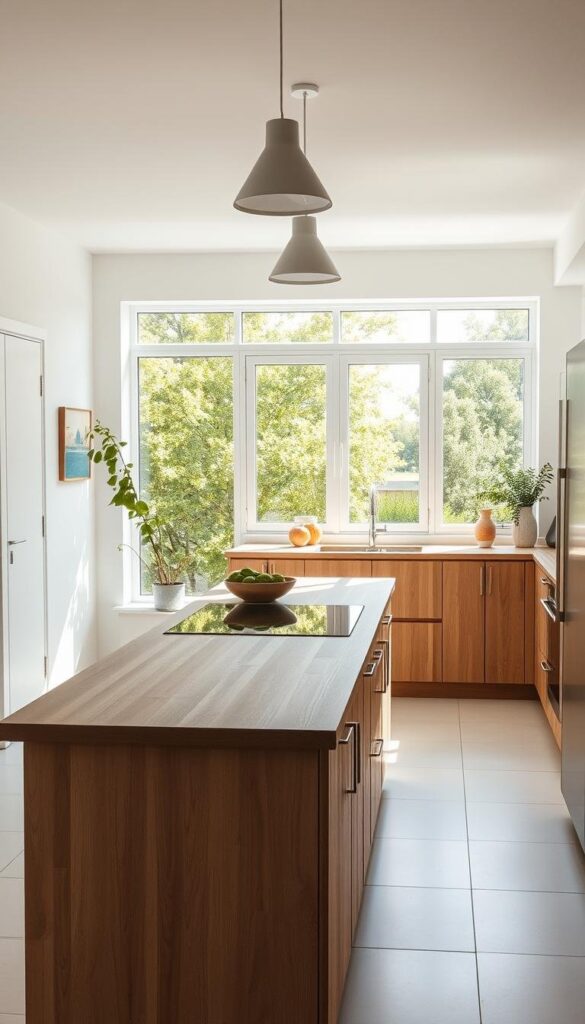
Definition of a Green Kitchen
A green kitchen focuses on sustainable kitchen ideas that are good for the environment. It uses materials like bamboo countertops, energy-saving appliances, and non-toxic finishes. For example, IKEA’s recycled particleboard or GE’s ENERGY STAR®-rated appliances fit this bill.
Benefits of Going Green
- Cuts energy bills by 30% through efficient appliances.
- Improves indoor air quality with low-VOC paints like Benjamin Moore’s Natura line.
- Reduces landfill waste via composting systems and reusable storage containers.
Key Features of Sustainable Kitchens
Here are some key features of a green kitchen:
- Materials: Recycled steel sinks or FSC-certified wood cabinetry.
- Appliances: Energy-saving models from brands like Whirlpool or Thermador.
- Design: Built-in recycling stations or solar-powered task lighting.
Every choice, from faucet to flooring, makes the kitchen better for the planet.
Choosing Eco-Friendly Materials
Building a sustainable kitchen begins with the right materials. Organic kitchen materials and green renovations help the planet and add character. Let’s look at top picks for countertops, floors, and cabinets.
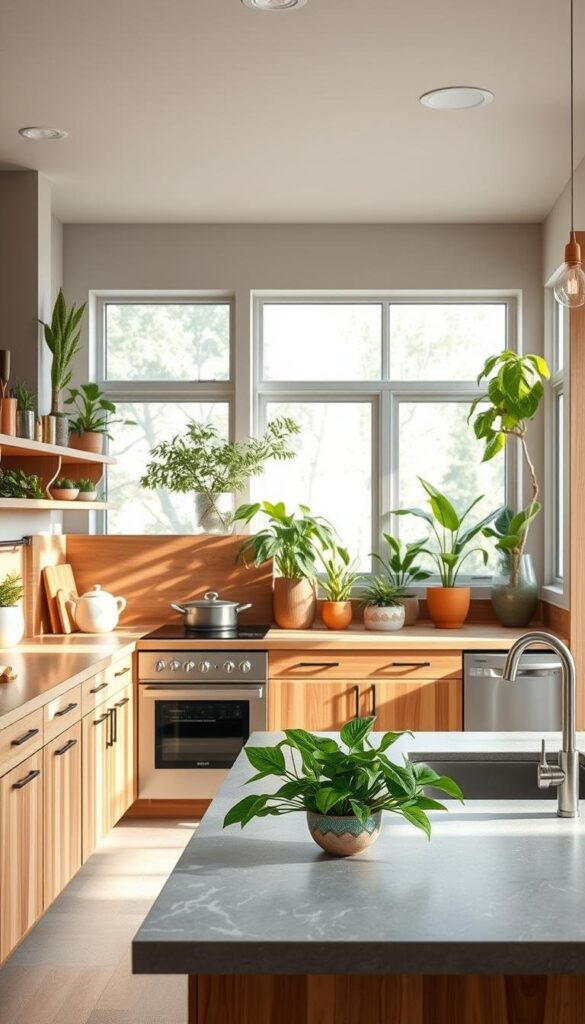
Sustainable Countertop Options
Countertops set the kitchen’s tone. Here are eco-friendly choices:
- Recycled glass surfaces from brands like Icestone blend durability with recycled content.
- Bamboo countertops, such as those from Bamboozle, grow quickly and resist stains.
- Reclaimed stone or FSC-certified quartz minimize waste while maintaining elegance.
Eco-Conscious Flooring Choices
Flooring choices matter. Options like cork, linoleum, and reclaimed wood reduce carbon footprints:
- Cork flooring (e.g., 77Cork) insulates and absorbs sound naturally.
- Linoleum by Forbo combines renewable resins with slip-resistant surfaces.
- Reclaimed hardwood planks add rustic charm without harming forests.
Environmentally Friendly Cabinets
Cabinets can be stylish and eco-friendly. Look for:
- FSC-certified woods like oak or maple from brands such as Green Forest.
- Formaldehyde-free MDF or bamboo composites from companies like Pottery Barn.
- Non-toxic finishes that reduce indoor air pollution.
“Choosing these materials isn’t just practical—it’s a statement about what you value.” — EcoKitchen Design Co.
Every choice in green kitchen renovations balances beauty and ethics. Explore these options to create a kitchen that’s as kind to the earth as it is to your lifestyle.
Energy-Efficient Appliances
Choosing the right green kitchen appliances makes your kitchen eco-friendly. It saves energy and money. Look for Energy Star certifications, which mean the appliances are very efficient.
Understanding Energy Star Ratings
The Energy Star label shows the best appliances. They use 10–30% less energy than others. This label checks things like how well they keep cold and how much energy they use.
For example, Energy Star refrigerators can save up to $100 a year. This is compared to non-certified ones.
Top Energy-Efficient Brands
- LG: Their refrigerators use 30% less energy with inverter linear compressors.
- Whirlpool: EcoCycle™ settings on their dishwashers save 20% on water and energy.
- Bosch: Their dishwashers use condensation drying, avoiding energy spikes.
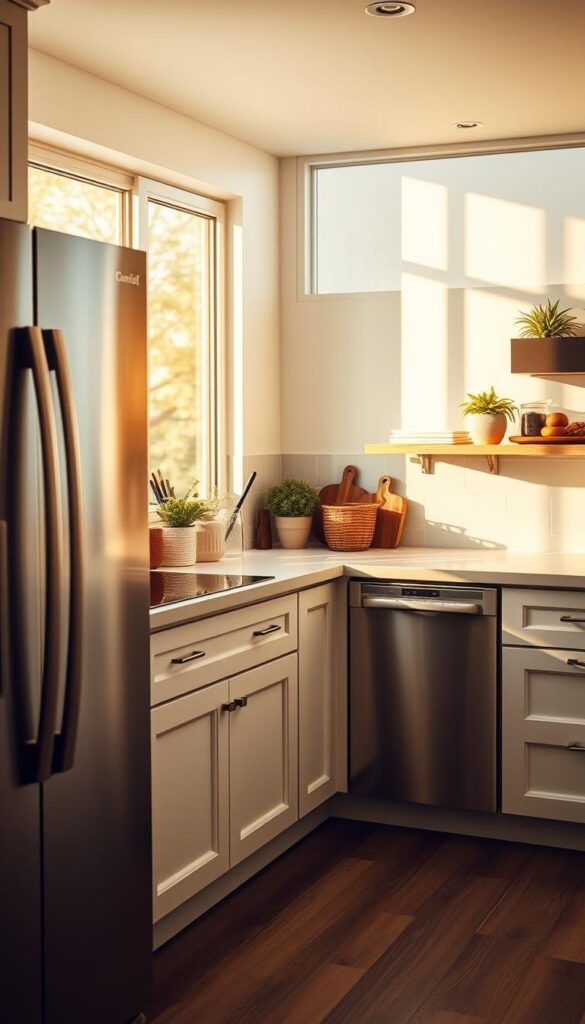
Benefits of Smart Appliances
Smart tech makes energy-efficient kitchen solutions even better. They save energy actively. Features include:
- Remote temperature control via apps
- Auto-shutoff for unused devices
- Real-time energy usage tracking
“Smart appliances aren’t just convenient—they’re a key part of modern sustainability.” – Sarah Green, Energy Efficiency Consultant
Choosing Energy Star-certified models like LG or Bosch can save money. You can get your money back in 3–5 years. Adding smart tech to these models boosts savings and eco-friendliness.
Sustainable Kitchen Design Principles
Smart design choices make kitchens eco-friendly. Eco-friendly kitchen design focuses on layouts that are both stylish and green. Every choice affects energy use and comfort.
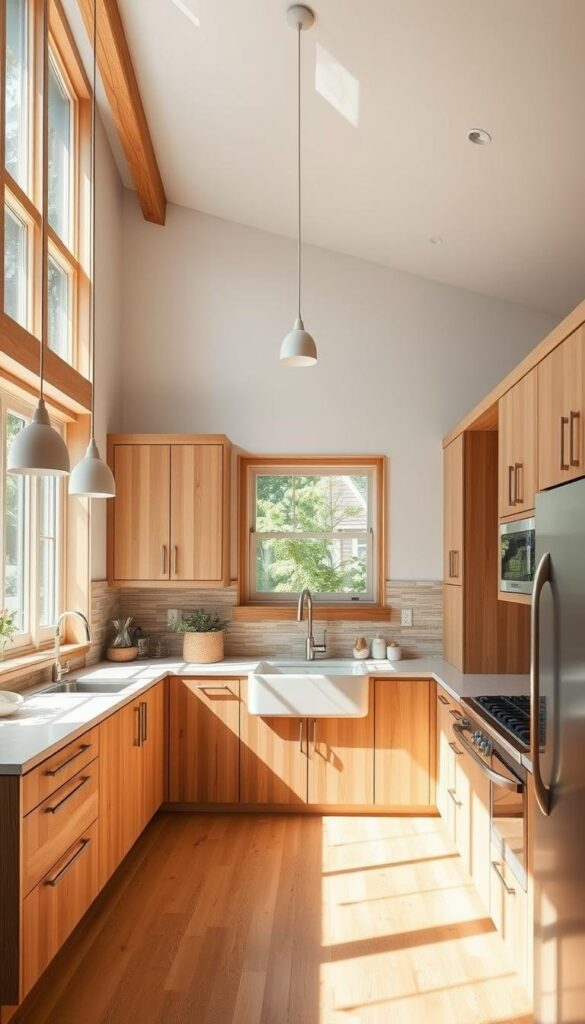
Open-Concept vs. Traditional Designs
Open layouts save energy by cutting down on walls. But, traditional kitchens keep temperatures steady. Try mixing styles for energy savings without losing space.
Maximizing Natural Light
- Skylights and solar tubes brighten spaces without lights.
- Light-colored walls reflect daylight, cutting electric use.
- South-facing windows harness sun for year-round warmth.
Incorporating Indoor Plants
Plants like snake plants and basil improve air quality. Place herbs near windows for easy access. Potted ferns add moisture and style.
Sustainable kitchen ideas come alive when plants, light, and layout combine. These choices make spaces both green and welcoming.
Water Conservation in the Kitchen
Turning your kitchen into a green space starts with saving water. Every drop you save helps the planet and cuts down on bills. Simple changes can make your kitchen both eco-friendly and efficient.
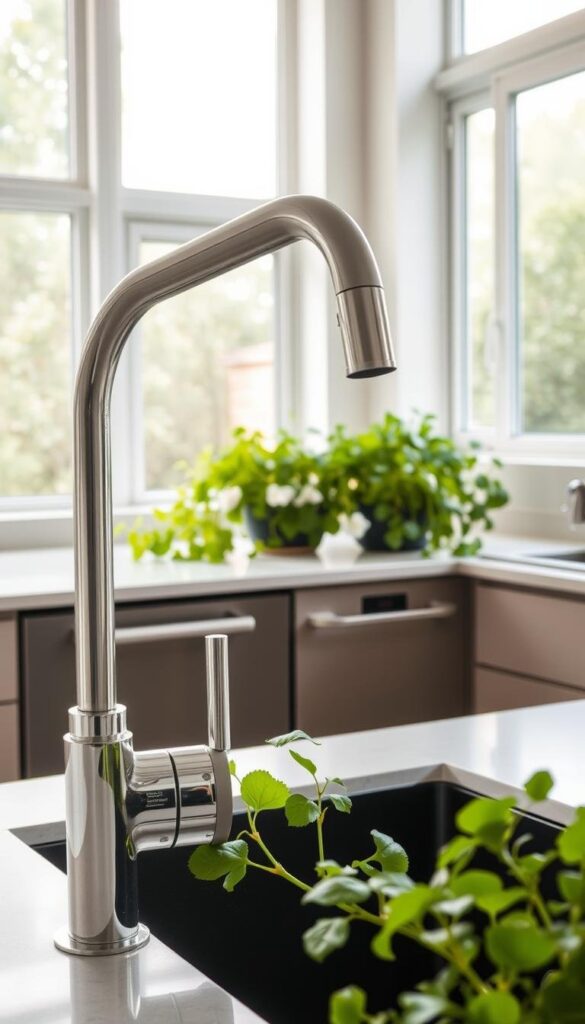
“Water conservation isn’t a luxury—it’s a responsibility for future generations.”
Low-Flow Faucets and Fixtures
Switch to faucets with aerators to save water without losing quality. Look for brands like Delta HydraLuxe or Kohler Sensate for style and savings. Fixtures with shut-off valves can save up to 30% more water.
Water-Saving Devices and Daily Habits
- Install faucet aerators (Brizo or Moen) for instant efficiency.
- Use a timer to limit handwashing time—try 1 minute for scrubbing.
- Keep a water jug in the fridge to avoid running taps for cold drinks.
- Choose Energy Star-rated dishwashers like GE or Bosch that use 3-5 gallons per cycle versus 20+ by hand.
Rainwater Harvesting for Cooking
Collect rainwater with systems like Rainsoft for plants or rinsing food. Use first-flush diverters to skip dirty water, then filter with UV purifiers. Start small with a 50-gallon barrel to reduce stormwater runoff.
Waste Reduction Strategies
Start making your kitchen more sustainable by reducing waste. These sustainable kitchen ideas help you adopt eco-friendly habits easily. You don’t have to change your whole routine.

Implementing a Composting System
Composting turns food scraps into nutrient-rich soil for your garden. It also cuts down on landfill waste. For small kitchens, use countertop bins like the ECOHearth 4-Liter Compost Keeper.
Outdoor composters or DIY piles work well too. Add fruit/veggie scraps, coffee grounds, and eggshells. But skip meat and dairy. Most compost systems take 2–6 months to be ready.
Using Reusable Containers
- Replace plastic wrap with Stasher silicone bags or Abeego beeswax wraps.
- Use glass containers like Pyrex or OXO Good Grips for leftovers.
- Carry groceries in Baggu cotton produce bags to avoid plastic.
Food Waste Reduction Tips
Plan your meals with apps like Plan to Eat to avoid buying too much. Freeze extra veggies for soups. Get creative with leftovers—turn old bread into croutons or broccoli stems into slaw.
Keep herbs fresh by storing them in water-filled jars on your counter. Small changes can make a big difference in an environmentally friendly kitchen. Start with one idea and add more as you go.
Sourcing Local and Organic Food
Expanding your green kitchen goes beyond design. It’s about choosing ingredients that are good for the planet. Start by looking into local and organic food. These choices help the environment and support local farmers.
Finding Local Farmers’ Markets
Use LocalHarvest.org to find markets near you. Talk to vendors about their farming methods and what’s in season. Building these relationships means fresher food and learning about sustainable farming.
Benefits of Seasonal Eating
“Seasonal eating cuts transportation emissions and preserves nutrients.”
Eating with the seasons is good for the planet. Winter veggies like carrots or beets need less energy to store. Check out the USDA’s Seasonal Produce Guide to find what’s best in your area. Try roasting Brussels sprouts or making soups with winter squash.
Organic Food Brands to Consider
Look for brands that care about the environment. Cascadian Farm uses recycled packaging, and Nature’s Path supports farming that regenerates the soil. Choose companies that use less plastic and are open about their supply chains. This helps you meet your organic kitchen materials goals.
Green Kitchen Decor Ideas
Make your kitchen greener with eco-friendly kitchen design. Choose wisely from paint to textiles for a healthier home. These tips will help you create a stylish, eco-friendly kitchen.
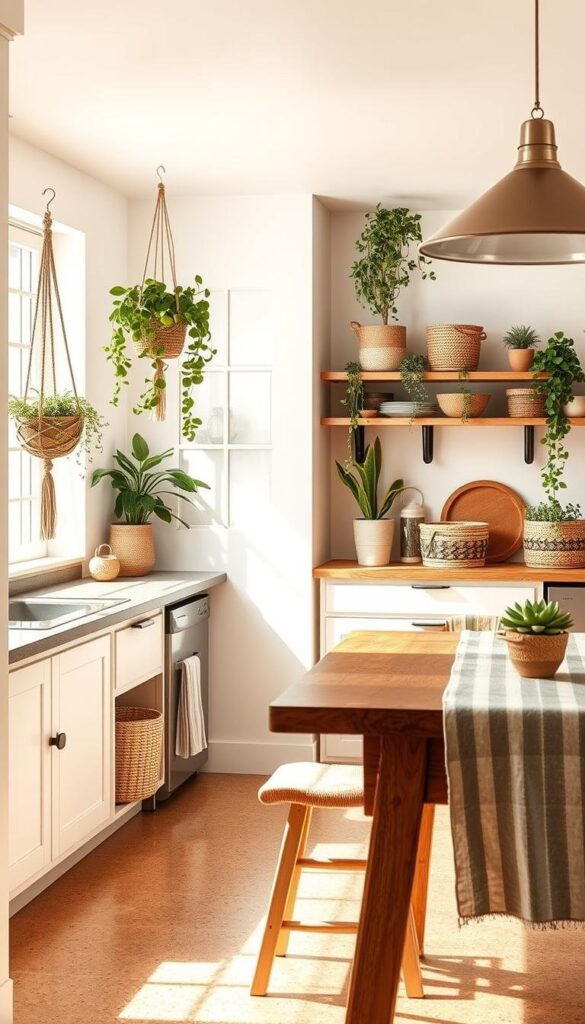
Non-Toxic Paints for a Breathable Space
Choose paints with low or zero-VOCs. Brands like Benjamin Moore Natura and AFM Safe Paints have great colors without bad fumes. Pick between matte or semi-gloss to fit your style and keep the air clean.
Sustainable Textiles That Last
Make your kitchen cozy with organic cotton towels from West Elm or hemp curtains by Boll & Branch. They last long and save money. Tip: Wash them in cold water to make them last even longer.
Upcycle Old Items into Showstoppers
Here’s how to make old items into new decor:
- Paint an old ladder with eco-paint for spice jar storage.
- Use mason jars as pendant lights with LED inserts.
- Repurpose wine corks into coasters with glue and fabric backing.
Small changes can make a big difference. Upcycling is good for the planet and sparks creativity!
“Sustainable decor isn’t just good for the planet—it’s a canvas for personal style.”
Planning Your Green Kitchen Layout
Smart layouts make small spaces work better. A good design saves resources and makes things easier to use. These tips help mix style with sustainability, fitting any kitchen size.
“Waste is a sign of bad design.” – William McDonough
Efficient Work Triangle Design
Try to place sink, stove, and fridge in a triangle. This design cuts down on steps, saving energy. Appliances should be 4–9 feet apart. IKEA offers modular systems to make this easier.
Smart Storage Solutions
Use vertical space with adjustable shelves. Stackable organizers and Blum’s sliding systems keep things tidy. Hidden pantries or angled drawers save floor space.
Multi-Functional Spaces
Small kitchens can be smart. Use fold-down tables or magnetic knife strips for extra space. Delta has pull-out trash bins that hide in cabinets, combining looks and use.
These ideas work for any budget. Even small changes, like better storage or a fold-out island, help. Every update moves you closer to a green kitchen. Whether you’re redoing or updating, smart planning makes a big difference.
DIY Green Kitchen Projects
Make your kitchen eco-friendly with these DIY projects. You can repurpose materials and grow herbs. Small changes can make a big difference without spending a lot.
Easy Upcycling Ideas
Turn old items into kitchen treasures. Use wooden pallets for shelving or mason jars for storage. Here are some quick ideas:
- Pallets → rustic pot racks
- Old windows → farmhouse-style cabinet fronts
- Glass jars → spice or utensil organizers
These green kitchen renovations give new life to old things. No tools? Paint a thrifted table with eco-friendly paint for a cheap update.
Building Your Own Herb Garden
Grow herbs all year with these easy setups:
- Use clay pots or recycled containers for basil and thyme
- Hang a vertical garden kit on a sunny wall
- Add LED grow lights for low-light spaces
Choose herbs like cilantro or rosemary for indoor growth. A small herb garden on your windowsill adds flavor and cuts down on store-bought waste.
Installing a Smart Thermostat
Save energy with a smart thermostat. Models like Nest or Ecobee learn your habits to save on heating/cooling. Here’s how to install:
- Check HVAC compatibility before purchasing
- Follow the manufacturer’s wiring guide
- Pair with a smartphone app for remote control
These energy-efficient kitchen solutions can cut energy bills by 10-20%. Start with a weekend project and see your savings grow.
Maintaining Your Green Kitchen
To keep your green kitchen looking great and eco-friendly, regular care is key. It helps your choices last for years. This turns sustainability into a long-term way of life.
Regular Eco-Friendly Cleaning Tips
Try making your own cleaners with vinegar, baking soda, and lemon. If DIY isn’t your thing, Seventh Generation has eco-friendly sprays. These options reduce chemical waste and keep your kitchen clean and green.
Sustainable Kitchen Upkeep Practices
Keep your energy-efficient kitchen in top shape by cleaning appliance coils and sealing leaks. Replace old filters in fridges and dishwashers to keep energy use low. LG and Bosch offer tips to make your appliances last longer, cutting down on replacements.
Seasonal Maintenance Checklist
Spring: Check faucet aerators for water efficiency. Summer: Clean range hoods and check ventilation. Fall: Inspect refrigerator door seals. Winter: Look for leaks in pipes. Always keep compost bins clean and rotate pantry items to avoid waste.
Small actions like these help you stay true to your green goals. Every step you take reduces environmental harm. A well-kept kitchen is more than a space—it’s a daily reminder of the power of small choices.
To bring you cozy inspiration more efficiently, we sometimes use AI to assist in content creation — but every word and idea is carefully shaped by our team. See our AI Disclosure for more info.







